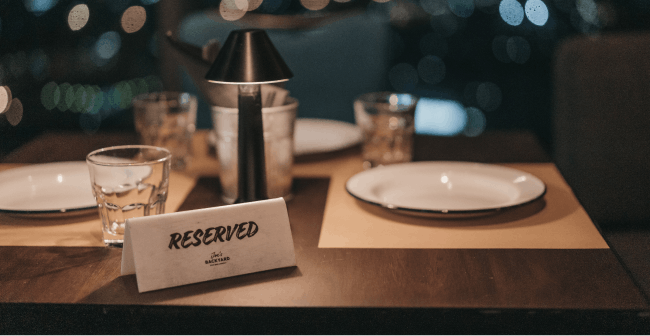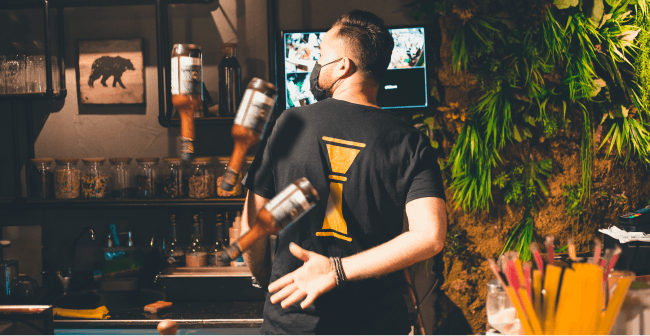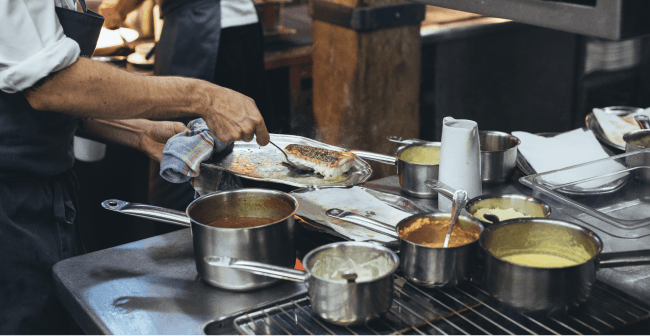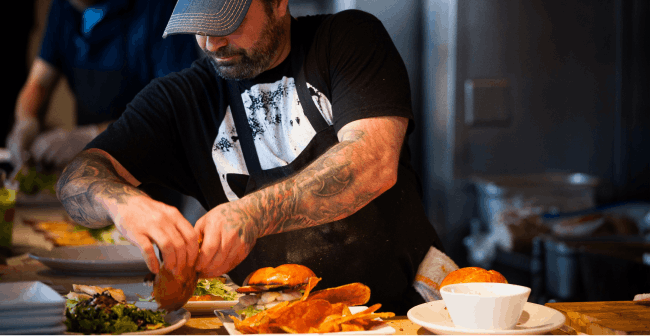
The Restaurant Labor Shortage: How Tech Can Provide A Service With Reduced Staff
Are you having trouble hiring staff? Do you want to know how you can fill your job openings with tech? You’ve come to the right place. In this week’s blog post, we share our key takeaways from US Foods’ ‘A Service with No Staff’ webinar.
Need help hiring? You’re not alone. Let’s take a look at the stats…
- According to the Bureau of Labor statistics, five and a half million employees left the hospitality segment during Covid
- 47% of operators agree that automation is essential to their future success
- The labor shortage is motivating restaurants to automate
How embracing tech can solve your staffing problems in big and small ways
When it comes to technology, many operators fear that screens will undermine the sense of human connection and hospitality they’ve worked to create within their restaurants. But restaurant tech and automation isn’t all robots replacing humans (though we’ll cover that too). What does the customer service experience look like at an operation that uses technology in place of staff? The team at US Foods uses a framework they call The Customer Experience Cycle that includes five key stages: Pre-arrival to arrival, Ordering, Ticket preparation, Food running, and finally Payment and Post-visitation.
Customer pre-arrival stage
Let’s start with technology’s role in the pre-arrival stage of the customer journey. Did you know that 75% of your potential customers decide where to eat based on search results? Using tech to appear more often in online searches is a simple and effective way to capture more business.It’s also a simple step toward reducing staff phone time. Think about it: how much does your team spend answering questions on the phone? Do they offer the best hospitality possible? If you’re already crunched for labor, is phone work the best use of your employees? Providing accurate and comprehensive info online is one of the many areas in which tech shines.

Pre-arrival checklist:
1. Optimize your Google Business Profile: Did you know that the average optimized Google Business Profile listing gets 5x more views than a listing that has not been optimized? Google is essentially the modern-day phonebook and will automatically fill out the information on your page with what it finds—so first things first, make sure to edit the info on your page for accuracy. Make sure to list the correct hours, contact info, address and upload your complete, current menu. If you’re interested in learning more about how you can create and optimize your restaurant’s Google Business profile, check out this article on the Otter blog.
2. Build your Google Business Profile Q&A section: Dropping in FAQ (frequently asked questions) on the Google Business Profile Q&A section, as well as on your website, is another strategic way to set the customer’s expectations, capture new business and reduce the time staff spends on the phone in the pre-arrival stage. Here are some examples of questions to include: Is there parking? Do you offer gluten-free, dairy-free, or plant-based options? Can I bring my dog with me? Is there outdoor dining?
3. Repurpose social content on Google posts: If you already have content on your restaurant’s website and social media channels, repost it on Google posts to boost SEO.
4. List your menu online: 93% of customers look for online menus before dining out or ordering in, so ensure your menu is fully up-to-date and listed on your website. Google Business Profile, Facebook and IG highlights. Providing your customer with the exact items available will reduce the time it takes for your staff to relay info on the phone.
5. Include a Call to Action button: Call to Action buttons are a fast way to move a customer through the call cycle. The customer is looking at the item(s) they're interested in. You've got their full attention. Do not miss this opportunity. Insert a button that enables them to engage with your product on the spot. Online ordering is the most common button to use but you can also insert a reservation button. Call to Action buttons inevitably reduce the time staff spends on the phone talking to customers through either process.
6. Use an auto-attendant: The good thing about robots is that they never scroll Instagram during a shift, get sick, act cranky or quit. Using an auto-attendant can save guests hold times and share FAQs. It also provides a better employment experiment for your staff, freeing them to focus on in-house operations. If you’re considering using auto intelligence, there are two options: Orderscape (a feature similar to Alexa) or valiant AI (a drive-thru attendant replaced with conversational technology).
7. Reservations: Requiring reservations helps you manage orders and increases customer touch points. It creates a channel for guests to send feedback about their experiences, ultimately increasing the probability of a customer returning to your restaurant.

Customer arrival stage
Before we get into delivery, let’s cover the top lessons we learned from the US Foods team on navigating the dine-in phase of the customer experience—while understaffed.
1. Hang up a trendy “Seat Yourself” sign: If you don’t have a host in the front of the house, hanging up a Seat Yourself sign helps customers feel taken care of and receive their food faster.
2. Use a tablet with SMS-based communication: SMS-based tablets can send an automated text to your customer for seat availability, timing and direction to their table.
3. Reduce menu size: Assess your menu for low-performing or supply-chain-insecure items. Having less variety on your menu can also mean providing faster service and higher employee satisfaction. You can also find what some restaurateurs refer to as “speed scratch:” ingredients that can easily be used for multiple meals.
4. Streamline your bar for execution: Free up your bartender’s time so they can cross-train as a host or server by preparing and selling alcohol items in bulk. Pitchers of beer, bottles of wine, pre-mixed cocktail specials, and to-go cocktails are all-time-savers.
5. Handheld POS: Investing in a handheld POS increases order accuracy and speeds up table turns—allows the kitchen to receive the order faster, so customers get their food 3-5 minutes faster. (Hot tip for Otter customers - we integrate with a number of the leading point of sale companies).
6. QR code ordering: Set up QR code ordering so your customer’s orders can go straight from their phone to the kitchen.
7. Counter service: Are you able to set up an order counter? If so, consider providing counter service to eliminate the need for multiple servers. In this self-serve model, numbered tickets can be done in many different ways—buzzers, texts, hand-held tickets.
8. Self-service beverages: Take a look at this picture of the Wild Eagle Saloon in Cleveland and their self-service draft wall. Customers can help themselves to their choice of beer.
9. The rise in Robot Deliveries: Yandex and Grubhub partnered to bring Ohio State students delivery 9 a.m. - 9 p.m. Integrated with meal plans, this service is being implemented in over 250 colleges and we are likely to see more delivery robots in the future. Some restaurants have already invested in these friendly machines to eliminate the need for staff.

With all this robot talk lets talk about handling pushback
With this new normal, you’re inevitably going to face objections from your guests. They might wonder why they’re doing all the work, what happened to the customer service etc. Respond calmly and discuss the labor shortage and how tech can also enhance their experience with speed and accuracy. Make sure to train staff to handle conflicts that arise and integrate tech into your restaurant’s marketing strategy, so your customers know what to expect. Including a promotion with 10% off can also help promote your restaurant’s tech replacements as a positive solution to an unprecedented and challenging few years.

Customer Post-Visit Stage
After your customer leaves your restaurant, there are still opportunities to continue the conversation and encourage repeat dining. Here are our top takeaways from the US Foods team’s advice on the customer service experience.
1. Use data collection: Use the data you collect from reservations and delivery to understand your restaurant’s performance, predict business needs and grow sales.
2. Manage reviews: Managing reviews can feel like a huge pain—especially when you’re understaffed. You’re in luck; after reading 1000 online reviews, the Otter team has compiled a downloadable template for responding to reviews both good and bad.
3. Prioritize your delivery business: Delivery is predicted to grow 300% faster than dine-in and already accounts for 40% of total restaurant sales. If you simply don’t have the bandwidth or staff to dine–in, consider converting into a delivery-only model.
- Skyrocket your sales with virtual brands: Use your existing space, staff, and inventory to fulfill more orders in multiple cuisine types under different brand names.
- Add extra delivery-only brands that use your store's current inventory.
- List your new digital storefront on delivery apps and start selling instantly.
- Watch your orders increase and flow directly into your Otter tablet.
4. Partner with Otter
Low on staff? Otter integrates all online orders onto a single tablet that can link right into your POS—no more manual entry, no more mess. Put an end to delivery headaches with Otter’s innovative and straightforward restaurant management solutions.

Want to succeed in delivery alongside Otter? Fill out the form below to get started!
Today's blog post is based on content from our partner US Foods®.
Otter is a proud member of US Foods® CHECK® Business Tools, a program designed to enable restaurants to Simplify Staffing, Reduce Waste, and Drive Traffic. US Foods also hosts regular live and on-demand webinars that span a wide range of topics to help restaurants increase revenue, operate safely and unlock their maximum potential.

Book a demo to see how Otter’s all-in-one platform can help your restaurant thrive.